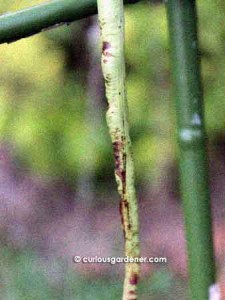
The day prior to this photo and the spraying of suds, these papayas were about 40% covered with mealybugs.
You know that song from the movie, South Pacific – I’m gonna wash that man right out of my hair? I sure wish I could do that with the pests on my plants!
In fact, I sort of did that, after doing some research into getting rid of stink bugs and getting the suggestion from a recent visitor.
Patrick recommended using a little dishwashing detergent with water in a water spray bottle, which he had found effective against mealybugs on papaya trees.
I also found a video on YouTube showing how a solution of water and detergent seemed to kill, or at least immobilize, stink bugs really quickly. (It’s a little roundabout – skip to 4:00 or so for the actual spraying of the bugs) Since I had these pests on my long bean plants, I decided to test this theory.

The day after being sprayed by suds, the long beans didn't have any more stink bugs, but they were spotted and streaked by the solution.
Now, I can’t remember where exactly I got the proportions from because I read and watched quite a number of articles and videos, but I ended up making a solution of about equal parts detergent and water. After mixing it up, I headed for the long bean plants and sprayed the few stink bugs I could see. (Of course they went into hiding once I had something I could use against them!)
When you spray a soapy solution from a spray bottle, it tends to froth up, which is great. The soapy bubbles coated the stink bugs, and they stopped moving almost immediately.
I was so thrilled that I immediately started using the solution on other pests on other plants – small hairy caterpillars and lots of small ants spreading aphids on the angled loofah vine, and mealybugs on the fruits and leaves of the papaya tree… It was great! I imagined the soapy froth suffocating them as I sprayed them liberally.
And then the following day, I found that the leaves of the plants that I had sprayed had started turning brown and were curling up. Whoops, I think I overdid it with the strength of the solution!

The papaya leaf started drying up where the soap suds had been sprayed. Maybe I should have rinsed off the leaves after a couple of hours.
It’s also likely that I should have waited for even later in the day, when there was less sunlight on the plants. Other plants nearby that had been splattered by the soapy spray also had lots of little brown spots on them, so even though this soapy method appears to have rid our plants of stink bugs and most of the mealybugs (ants and caterpillars were still around the next day), the effect on the plant leaves was a definite drawback.
I’ll try this again with a less concentrated soap solution and observe the effects.
© 2012 curiousgardener.com All rights reserved.

I don’t know what stink bugs are. I use a solution of dish liquid soap, antiseptic mouthwash, and castor oil to spray on plants that are infested with pests, all kinds. So far, it has worked pretty well for me. To keep plants pest-free is a never- ending task :-(. I first hose as many pests away with a stream of water (sprayer set on “JET”), then spray with solution. My spray bottle holds abt 20oz of water and to that I add a tsp. of dish soap, approx. 3 tbs of mouthwash and 1/2 tsp. of castor oil. Ingredient amounts don’t hv to be an exact science. I learned the hard way, spraying plants in the daytime when it was hot and ended up with brown foliage. Now I do it only in the evenings and no more “burnt” foliage.
I have sprayed off the pests with water, particularly the out-of-reach parts of the papaya trees, but that doesn’t get rid of them permanently because they can just make their way back up. That’s why I sprayed the mealybugs directly. The stink bugs also have a tendency to fly straight at whatever is threatening them, and they emit a kind of citrussy stink that I don’t like when they’re upset – which is why I wanted to “sud” them immediately. I sure wish I’d remembered to wait until later in the evening to spray the plants though.
I chanced on your site searching for vegetable gardening tips. I must say you have a great site and a beautiful garden!! Any tips for combating tomato diseases? Year after year, I seem to have no luck with growing tomatoes. Any pointers?
Welcome to the Curious Garden, Blossom, and thanks!
I’ve had lots of problems growing tomatoes as well, if you look back on the tomato threads. What I hated most were the whiteflies and mealybugs that descended on the plants, and rather than have pest-attracting plants, I decided over a year ago to stop growing tomatoes. My philosophy is, if the plants need too much maintenance, I won’t grow them any more.
I think on GCS, the general guidelines are: one or two squirts of dishwashing liquid and one tablespoon of cooking oil to 1.5L of water. Although, sometimes even this proportion can be too strong, so we’re advised to water the plants about an hour before spraying this white oil solution so that the plants have built up a store of water for more protection.
Sky =)
Thanks for the info, Sky. This is one of those instances where I have to learn from my mistakes.
*hugs hugs* It’s okay. I think the plants will be okay given a week or two. New leaves should grow quickly I think.
Aw… thanks, Sky I just feel bad for the plants, even though I know they’ll keep trying to grow. Bad Mama CG…
I just feel bad for the plants, even though I know they’ll keep trying to grow. Bad Mama CG…
Thanks! I tried the other suggested solutions on this site (from Miki and Sky) and what I found on Google – a mixture of baking soda, dish liquid and vegetable oil (all 1 tbsp each) with half gallon water, on the tomatoes last evening. They don’t look any better to me today, but will keep watching. For good measure, I also doused the okra seedlings nearby with this mixture, but don’t think that was such a good idea. Most of them got brown spots on their leaves today.
Good luck with your attempts, Blossom. With these things, it’s a matter to trying different things until we find what our plants respond to. I hope you get the right formula soon!